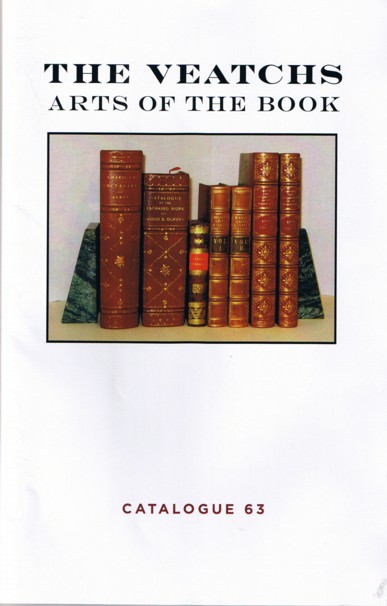Books as Art from The Veatchs

Books as Art from The Veatchs
By Michael Stillman
The Veatchs Arts of the Book recently issued their Catalogue 63: Recent Acquisitions. The Veatchs are focused on books as works of art, notable for features such as quality of printing, illustrations, bindings and paper. Naturally, books are generally designed to impart information, just as paintings are meant to present images. However, as some paintings of a scene are far more attractive than others, some books display their words in a more appealing setting than others. These are the types of books you will find in a Veatchs' catalogue. Here are some of the books offered this time.
Item 94 is a two-volume set from 1843 that has drawn such raving comments from critics as "the most handsome book produced in the whole nineteenth century," and "contains some of the most exquisite work that has ever been done in the history of printing." The book is Dresses & Decorations of the Middle Ages, by Henry Shaw. It contains copperplate engravings of paintings, miniatures, stained glass, furnishings, clothing, jewelry, gold and silver. Each is richly hand colored. The plates come with two pages of history and commentary about the item portrayed. However, the most outstanding feature of the book is not the plates, but the color-printed initial letters, ornaments and woodcuts. The Veatchs describe this work, which comes in a beautiful binding by Riviere, as "a fine set of this remarkable and exquisite specimen of color printing." Priced at $2,500.
Here is another spectacular printing performance from the 19th century: The Nature-Printed British Sea Weeds, by William Grosart Johnstone and Alexander Croall. This four-volume work features the nature-printing process of Henry Bradbury. Bradbury developed a process (or, perhaps, to some extent, "borrowed" the concept) whereby specimens were placed between a hard and a soft metallic plate, to create something of a three-dimensional image. Bradbury was best known for his images of ferns, but this one takes us to plants that lived below the waterline. Along with the three-dimensional effects, nature printing provided great fidelity to the details of the structure and lace-like features of these plants. Unfortunately, it was a difficult and expensive process, and few ever employed it. Bradbury found himself in a dispute with Alois Auer, who had earlier devised a similar if less impressive process, and committed suicide in 1860 at the age of 29. Item 57. $2,500.
Many still regard Thomas Bewick as the greatest wood engraver of all time, though he lived two centuries ago. His specialty was engravings of birds and other animals. Fortunately, a great many of his woodblocks have survived, and have been used in more recent printings. Item 55 is a recent attempt to track some of these down: Thomas Bewick, the Blocks Revisited and Rediscovered. The Story of the Blocks in Chicago and their Provenance in Known Collections Since 1942. This book by William Hesterberg was published last year. Hesterberg traces 1,350 blocks from Bewick's personal collection which made it to Chicago's Argus Bookshop in the early 1940s. About half of them have been located. Item 55. $300.